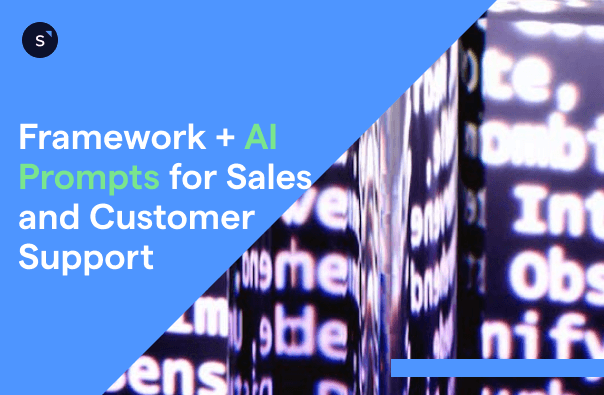Framework + AI Prompts for Sales and Customer Support
TL;DR: Quick Summary
How to apply the C.L.A.R.I.T.Y. framework to create agents that are truly functional across your core business teams.
Many businesses struggle to harness the full power of Artificial Intelligence because they treat it like a simple search engine.
To achieve consistent, high-quality, and useful outputs, successful users adopt a structured approach, viewing the AI as a highly capable employee that requires clear, actionable instructions.
This guide introduces the C.L.A.R.I.T.Y. framework—a foundational method for creating functional AI agents across your core business teams.
1. Unlocking AI Potential: The Power of Intentional Prompting
Intentional prompting is the key to moving beyond generic AI responses. When you apply a structured framework, you ensure every AI interaction is focused, constrained, and aligned with your business goals.
The C.L.A.R.I.T.Y. Framework Method Explained
The C.L.A.R.I.T.Y. framework provides the essential components for crafting high-value prompts, serving as the bedrock for all successful AI interactions. Each letter represents a critical element of the framework, as outlined in the table below.
2. General do's and don'ts for the C.L.A.R.I.T.Y. framework
Applying the framework consistently is essential to maximise your AI agent's effectiveness. By following these universal rules, you can guarantee a higher quality output regardless of business department.
✅ Do's: maximise your prompt effectiveness
Be hyper-specific with the role (R): Instead of "Marketer," use "SEO-focused Content Strategist with expertise in mid-funnel content." Specificity drives specialised output.
Force step-by-step reasoning (A): For any complex task (like qualification or analysis), add the instruction: "First, analyse X. Second, determine Y. Third, output Z." (This is Chain-of-Thought applied to the Action).
Define the exact output format (Y): Always specify structure, such as "a valid JSON object," "a bulleted list with emoji headers," or "a max 4-line chat reply." If you don't define the box, the AI will scribble outside the lines.
Set context first (C): Treat the Context component as the ultimate truth. If you update the Context (e.g., change the target product name), the AI must immediately adopt that new information.
Iterate and refine: If the output is slightly off, don't rewrite the whole prompt. Adjust one component (e.g., change the
Tone: from "Excited" to "Professional and measured") and try again.
🚫 Don'ts: Common Mistakes to Avoid
Don't use vague tones (T): Avoid generic words like "friendly," "nice," or "good." Use actionable tones like "empathetic and concise," "urgent but calm," or "professional and results-oriented."
Don't assume knowledge (C): Never assume the AI "knows" your product or internal terminology. Define every term, metric, and persona within the Context or Limits.
Don't forget limits (L): Without strict limits (length, excluded topics, reading level), the AI will wander. A prompt is not complete without defining what the AI cannot or must not do.
Don't mix roles (R): A single prompt should have a single role. Don't ask a "Technical Documentarian" to also act as a "Witty Social Media Manager." This causes internal conflict and poor results.
Don't Use 'write a paragraph' (Y): This is the ultimate failure of Yield. It gives the AI no constraints. Always specify sentence or word counts, or a specific output structure.
3. High-impact AI prompt examples by business function
Applying the C.L.A.R.I.T.Y. framework to specific business functions allows you to create specialised, functional AI agents that drive revenue and improve customer satisfaction.
AI prompts for your sales agent
A Sales AI agent must be a savvy, solution-focused B2B Sales Development Representative (SDR). The goal is to efficiently qualify leads and prepare for agent handover.
AI Sales Agent Prompt Examples:
Scenario 1: Pricing Comparison
📌Prompt: Act as a trusted, consultative Sales Advisor. Draft a diplomatic WhatsApp message (max 5 sentences) that justifies the price by detailing our two core strengths in a respectful, value-focused tone, in response to the prospect's query. You MUST NOT mention the competitor's name or offer any discounts, and your yield must be a concise, one-paragraph chat snippet ready for immediate send.
Scenario 2: Internal lead qualification
📌Prompt: Act as a rigid salesperson and analyse the lead data (Company Size: 45, Industry: Marketing Agency, Location: London, UK, Tools: Teams, HubSpot), using a 1-5 qualification score and providing a rationale for the score in a bulleted form.
AI Prompt for Your CS Agent
A Customer Success AI agent should be empathetic, calm, and professional (Tone), acting as a Customer Success Manager or a highly knowledgeable Technical Support Specialist (Role).
AI Customer Support Prompt Examples:
Scenario 1: FAQ Generation
📌Prompt: Act as a CS frontliner and convert the resolution steps into a concise, non-technical FAQ entry for a public-facing help centre. Provide them in a clear, bulleted, question and answer format, in a helpful and instructional tone.
Scenario 2: Internal Escalation Summary
📌Prompt: Act as a concise and accurate technical Customer Service Manager. Review the provided ticket history (representing 5 paragraphs of complex error reporting) and summarise the core problem for the engineering team, limiting the summary to a maximum of 3 formal and objective sentences, in the format of a Slack message.
Conclusions
The C.L.A.R.I.T.Y. framework is a skill that must be cultivated. By treating your AI agents like the valuable employees they are and providing them with explicit, structured instructions, you can unlock immediate, high-quality, and scalable results across your entire business. Always remember to iterate and refine your C.L.A.R.I.T.Y. prompts for continuous improvement.
🚀 Unlock your unlimted AI Agent credits!
Available to all SleekFlow users—build and launch your first AI agent today!
Share Article
